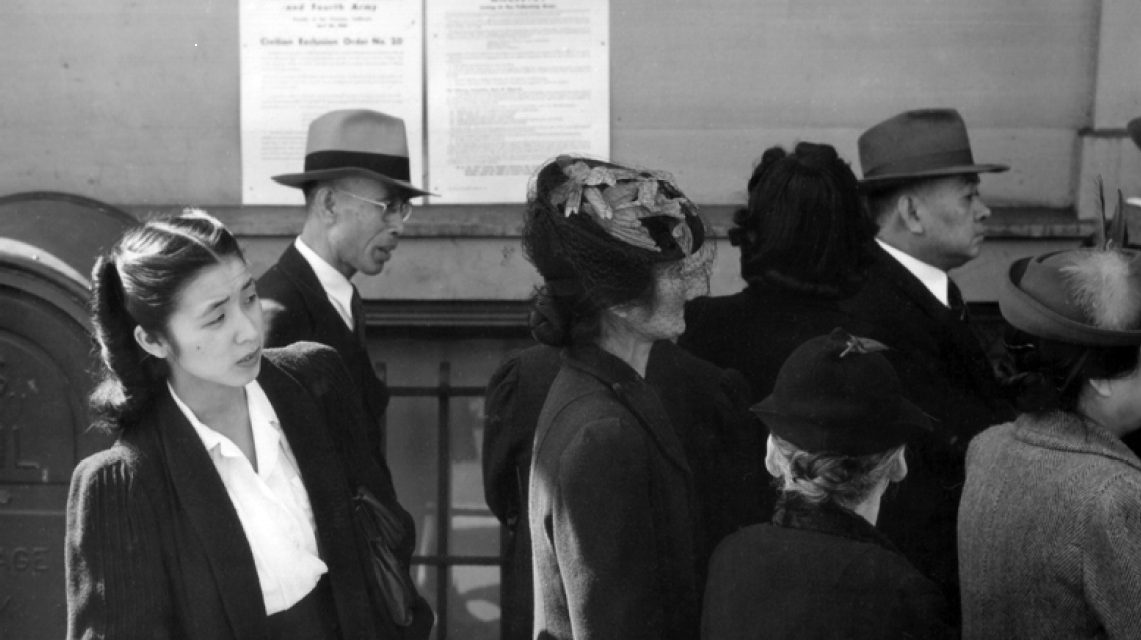Imagine a country where people are forced from their homes and stripped of their liberties – their only crime being different from the majority.
Think of Hitler’s persecution of Germany’s Jewish population. Consider Stalin’s Soviet dictatorship, which imprisoned his political opponents. Now think of the United States, where fear of the country’s Japanese population has reached a new high.
While America will undoubtedly refrain from such purges, the country has joined its European and Russian counterparts in discriminatory imprisonment. On Feb. 19, President Franklin D. Roosevelt ordered all people of Japanese ancestry residing on the West Coast to leave their homes. With Executive Order 9066 signed into law, the forced relocation of said people – some citizens, some not – has already begun.

Japanese-Americans waiting to be processed for relocation. From Wikimedia Commons.
In the Executive Order, Roosevelt argued that the country must employ all measures when it comes to national security. Fearing a potential Japanese assault on the West Coast, he hopes to keep any potential enemy spies corralled and unable to do any harm.
“The successful prosecution of the war requires every possible protection against espionage and against sabotage to national-defense material, national-defense premises, and national-defense utilities,” Roosevelt states in the controversial order. “I hereby authorize and direct the Secretary of War, and the Military Commanders… to prescribe military areas in such places and of such extent as he or the appropriate Military Commander may determine, from which any or all persons may be excluded, and with respect to which, the right of any person to enter, remain in, or leave shall be subject to whatever restrictions the Secretary of War or the appropriate Military Commander may impose in his discretion.”
With the United States at war with Japan, the president’s order does not come as a complete surprise. The notion that Japanese-Americans who still feel an allegiance to their former country could form a “fifth column” has been discussed since Japan attacked Hawaii’s Pearl Harbor naval base on Dec. 7, 1941. But if all such people are forced inland, none will be close enough to assist the enemy in the event of an attack.
Already, Japanese removal has begun. In California, more than 800 Japanese aliens were taken in raids, while another 100,000 in the state, all considered enemy combatants, await their fate. Internment camps (or “military areas,” as Roosevelt calls them), have begun to pop up in remote, inland areas in several Western states. Countless Japanese-Americans are being brought to these camps without charges, regardless of their citizenship status.
Many, like Mike Masaoka, national secretary of the Japanese-American Citizens League, are complying with the United States government. Still, Masaoka said that people like him have “every right to protest.”
As controversial as the government’s actions may be, many officials are trying to explain why Japanese internment will benefit the country as a whole.
Following three days of raids in Northern California, the FBI chief for that region, Nat J. L. Pieper, said that “valuable data” had been recovered, though he would not delve into details.
While much of the country views Japanese-Americans as potential enemies, the ethnically diverse state of Hawaii is giving young Americans of Japanese ancestry a chance to serve their country. According to Lieut. Gen. Delos C. Emmons, volunteers in the area can go to the University of Hawaii and sign up for the Hawaii Territorial Guard – “for whatever service you see fit.”
Sources:
“800 West Coast Japanese Go to Enemy Camps as Army Maps Widened ‘Prohibited’ Zones.” New York Times, Feb 24, 1942, p. 11.
“RAID SIREN WAILS IN SAN FRANCISCO.” New York Times. Feb 19, 1942, p. 11.
“JAPANESE-AMERICANS IN OAHU LABOR CORPS.” New York Times, Feb 26, 1942, p. 4.
Transcript of Executive Order 9066, ourdocuments.gov. Available at https://www.ourdocuments.gov/doc.php?doc=74&page=transcript, accessed December 21, 2016.





